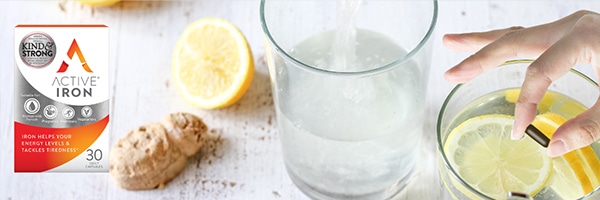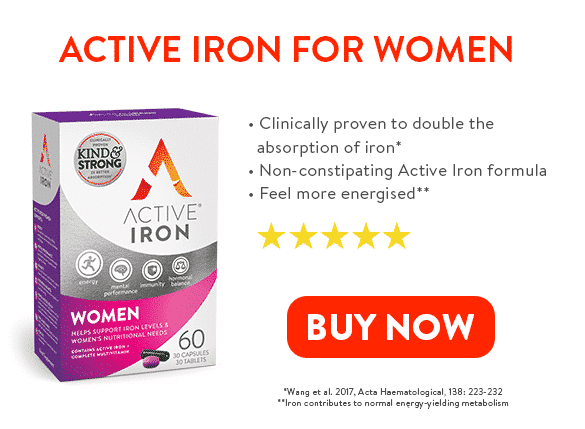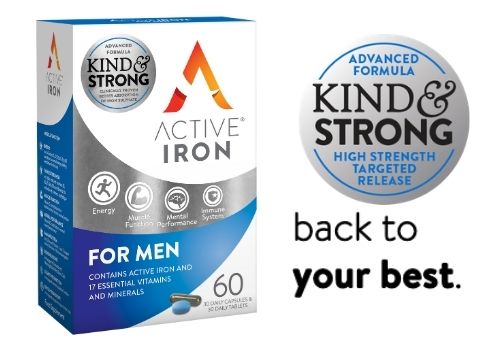The best time to take iron is on an empty stomach, so ideally at least one hour before or two hours after eating. Taking an iron supplement will depend on a number of factors which we’ll explore in full detail.
This article is for you if you want to find out:
- The best time to take iron for women,
- The best time to take iron tablets during pregnancy,
- The best time to take iron for men,
- The best time to take iron for vegetarians/vegans,
- The best time to take iron, before or after exercise,
- Why do you need iron,
- How to take iron pills correctly
- How it is absorbed in your body
Active Iron is easily absorbable, fast-acting, and works in harmony with your body’s needs.
When is the best time to take iron for women?
For adult and teenage females, the recommended minimum daily intake of iron is between 10 and 15 mg. The best way to ensure that your body completely absorbs iron is to take it on an empty stomach in the morning.
When is the best time to take iron tablets during pregnancy?
When you’re pregnant, you need at least 27 mg of iron every day, which is almost twice the amount you normally need. That’s because your body has an increased blood volume. Around 18% of all pregnant women in the U.S. don’t get enough iron from their diet.
Taking an iron supplement can help you reach your daily iron needs. A sustained suboptimal intake of iron can lead to suboptimal iron levels, resulting in your baby being born with low birth weight or too early.
Pregnant women with morning sickness or a sensitive stomach should take iron later in the day to ease their digestion.
When you’re breastfeeding, you’ll need at least 9 mg of iron every day, however for some women postpartum, their needs may be higher.
If you don’t have problems with your stomach (morning sickness, reflux, etc.), take your iron supplement first thing in the morning.
When is the best time to take iron for men?
Adult and teenage males need about 10 mg of iron daily to maintain healthy levels. Typically, men store more iron in their bodies than women.
However, they might still need to take iron, especially if they are participating in high-intensity exercise such as cycling or running. Also, if you have malabsorption issues such as IBS or low stomach acid, you may benefit from an increased iron intake.
If you decide to supplement with iron because you are feeling tired, experiencing low concentration, or any other signs you could benefit from increasing your iron levels, make sure you’re taking it first thing in the morning.
When is the best time to take iron when you’re vegetarian or vegan?
As a vegetarian or vegan, it’s likely that you have less iron in your body than people who follow an omnivorous diet. Many iron-rich, plant-based foods decrease your intake due to the high levels of oxalates in your food which block iron absorption. This is also true for iron supplements, so we would recommend taking iron away from your meals.
Experts recommend that vegans and vegetarians take an iron supplement each morning on an empty stomach. For better absorption, take it with a drink containing vitamin C.
When is the best time to take iron (before or after exercise?)
Lower iron intake is common in endurance athletes such as triathletes, marathon runners, etc., with almost 60 percent of all female athletes and 40 to 50 percent of all male athletes being affected by it in any given year. Researchers believe that athletes may need more red blood cells to carry oxygen during exercise.
If you have a low intake of iron-rich foods, supplementing to bring them up can improve your energy levels, as well as your physical and mental performance.
If you’ve checked your levels and you’ve realized that you need to supplement with iron, take it at least 1 hour before your workout or two hours post-workout to ensure optimum absorption.
Tips on how to take iron pills correctly
Our bodies absorb iron best on an empty stomach. Active Iron is clinically proven to improve iron absorption while reducing the likelihood of cramps, nausea, and diarrhoea. It is a good idea to wait at least two hours after having food if you forget to take your iron supplement on an empty stomach.
Why do you need iron?
Iron is an essential micronutrient. Your body needs iron to produce haemoglobin, a necessary ingredient in the production of red blood cells. Haemoglobin carries oxygen from your lungs to the rest of your body. Iron also contributes to the reduction of tiredness and fatigue and supports the normal function of the immune system.
Given how essential iron is for your body, it is a good idea to figure out if you’re getting enough iron from your diet. Keeping a diet diary or using an app to monitor your intake can be useful. If you are not meeting your body’s iron needs, you might experience some of the following*:
- Tiredness
- Paleness
- Shortness of breath
- Headaches
- Irregular heartbeats
- Weakness
- Poor appetite
This could be for a variety of reasons – too much exercise, malabsorption issues, or just a diet that’s low in iron.
Whatever the case may be, if you are unable to close the gap through diet alone, an iron supplement can help you to ensure that you’re getting an adequate amount of iron to meet your daily need.
How is Iron absorbed?
There are two types of iron – heme and non-heme iron. Heme iron can only be found in animal proteins, while non-heme iron is found in both animal and plant-based foods. Heme iron absorbs easier compared to non-heme iron.
Some foods, such as tea and milk, diminish your absorption of iron. (That’s why people who take iron supplements usually avoid these foods in the hours after taking their supplement.)
Because of this, the safest way to take iron supplements is on an empty stomach with water or a drink that contains vitamin C.
Research suggests that 80% of the world’s population doesn’t consume enough iron to meet their body’s needs.
To naturally increase your iron intake, you can start incorporating more iron-rich foods into your diet.
These include:
Shellfish
All shellfish are incredibly nutritious. Mussels, clams, and oysters are excellent sources of dietary iron. The U.S Department of Agriculture reports that 100 grams of clams contain up to 17 percent of your daily iron requirement – or around 3 mg. They are also incredibly high in vitamin C, which naturally eases absorption.
Spinach
Spinach is a source of non-heme, which means it usually doesn’t absorb well. However, spinach is also high in vitamin C, which is known to significantly improve iron absorption. 100 grams of spinach equals 2.7 mg of iron.
Red meat
Red meat is highly nutritious. One hundred grams of ground beef has 2.7 mg of iron. Meat is abundant in high-quality protein, several B vitamins, zinc, and selenium. It’s one of the most accessible sources of heme iron.
Turkey
Turkey meat, especially dark turkey, is chock-full of protein and iron. It’s a great source of a variety of vitamins and minerals. One hundred grams of turkey meat will give you an average of 1.43 mg iron.
Dark Chocolate
Tasty, nutritious, and rich in iron. 28 grams of dark chocolate contains, on average, 3.4 mg of iron. It also works as an antioxidant, promoting friendly bacteria in your gut. Make sure you’re aiming for dark chocolate with at least 70 percent cocoa.
If you decide to start supplementing with iron, the first thing you need to know is when to take it.
Conclusion
As a rule, people that take an iron supplement should take it in the morning, on an empty stomach, with water or a drink containing vitamin C. And for those who have a sensitive stomach, their best bet is to take their iron right after a meal.
But as you know, not all supplements are created equal.
When choosing your iron supplement, you should be aware of two major problems:
- Low absorption
- Stomach irritation
Finding and using an iron supplement that is easy on your stomach and improves your absorption will make it easier for you to stay consistent with a schedule.
* Note: These symptoms may indicate a medical condition, and this should be ruled out before deciding to increase your iron intake.
Other blog posts for you:



